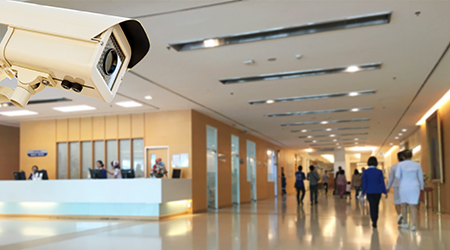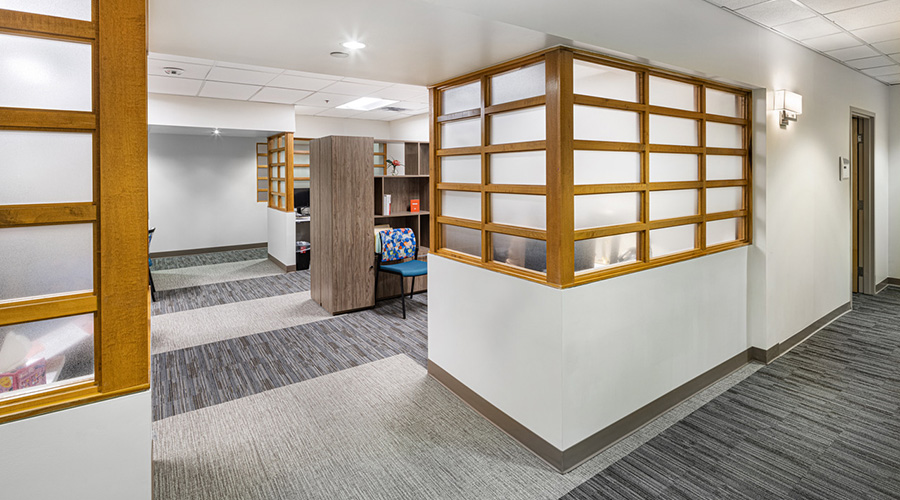Hospital security grabbed national attention during the pandemic as headlines told of personal protective equipment (PPE) theft and stolen vials of COVID-19 vaccines. These high-profile crimes have prompted healthcare facilities to give their security a second look.
Every hospital needs a comprehensive security and surveillance system to safeguard patients and employees, sensitive medical information, valuable pharmaceuticals, and high-tech medical equipment. Patients coming to healthcare centers for treatment trust that these facilities have a complete security system that includes access control, visitor management software, perimeter detection systems and alarms, intelligent lighting systems, sensors on doors and windows, and surveillance cameras.
“You must configure your systems to allow continuity of operations to occur but still maintain the appropriate protection measures for your buildings,” says Ray Gerwitz, executive director and deputy chief security officer at the University of Texas MD Anderson Cancer Center in Houston in a recent podcast.
Start with a security assessment
When was the last time you evaluated your physical security systems? Facilities often spend thousands on surveillance cameras and access control, then never consider the systems again. An assessment reviews existing technology to identify where security is strong and where weaknesses exist. Armed with this assessment, healthcare facilities can take steps to address areas needing improvement.
Your journey to better security begins with a comprehensive security assessment. These examinations provide a holistic view into the overall security of a healthcare facility.
A successful security assessment considers three key areas. It defines your objectives and what you want to keep safe; identifies threats, vulnerabilities, and risks; and compiles risk mitigation solutions.
Defining the objectives for your security systems is a critical piece of this assessment. What goals do you have for your security? Perhaps you want security systems to protect patients and employees, or maybe you want a security system to maintain hospital operations. Perhaps you’ve experienced a rash of thefts and want to harden security in areas where theft occurred. The answers to these questions identify which security solutions make sense and where.
An assessment also includes a walkthrough that evaluates existing security tools and their functionality. A thorough, focused security walkthrough examines the interior and exterior, the hospital grounds, parking lots, etc. A walkthrough considers the security systems that exist and identifies systems you need.
Controllable access control
Healthcare facilities must address two points — physical security and employee security — in every access control plan. The greatest security threats are often internal, coming from the employees themselves.
For this reason, every solid access plan begins with one that considers employee access. Installing access technology supplements this effort.
An access control solution breaks down a healthcare facility into controllable, role-based zones on a common platform. It’s necessary to put access control on main entrance doors and internal entrances and exits, then base who gets access to these areas on predetermined access levels. This ensures healthcare facilities can effectively monitor who goes in and out and moves within the facility.
Most healthcare facilities have many people coming through each day. A traditional key-based system cannot keep up with this level of activity. Heathcare centers require state-of-the-art, auditable, electronic access control systems. There are several access control systems to choose from: Code punch systems, credentialled systems, and biometric systems.
Code punch systems provide unique user codes as a matter of policy. While some allow for direct downloading of user data for auditing purposes, these systems are prone to code sharing, dead batteries, and wearing of numerical keypads that hint at the characters of frequently used codes. One code misappropriation is all it takes to eliminate the protection these systems offer.
Cards and key fob systems deliver intelligent access control. But they too carry risk. The typical card/fob-driven access control system incorporates software that allows certain cards/fobs to access specific areas during days and hours consistent with the work schedule and duties of the employee who holds the credential.
Credentialing systems provide a heightened level of access control and offer strong auditing capabilities, but the potential for lost, stolen, and misappropriated cards and fobs remains. You can limit this issue by not allowing employees to take credentials off-campus. Store cards and key fobs in a safe that only managers can access.
Hospitals can create an access point where employees sign for receipt and return of their access cards. Managers should account for cards and fobs daily, and healthcare managers should design policies that make individual “badging in” at each checkpoint mandatory (e.g., the policy should require Employee B to scan his card/fob at a control point even if he enters the area with Employee A).
Biometric access control is becoming increasingly popular and achievable. Modern access control systems use fingerprint and retina scans with high success.
These systems eliminate the need to manage physical credentials and the potential for the loss, theft, or misappropriation of key fobs or cards. Biometric systems are cost-effective and less cumbersome with fewer opportunities for credential misappropriation.
Access control should also include visitor management. As hospitals create an open environment for healing and patient support, they must adopt security at hundreds of ingress/egress points, each with varying levels of access. A visitor management system (VMS) helps manage and track visitors, allowing selective facility access and improving the overall visitor experience.
Consider also incorporating fire alarm monitoring into your access control system. Doing so ensures that doorways open in a fire emergency.
Video surveillance needs
Security camera systems comprise an essential part of a healthcare facilities overall security plan. These systems protect patients, safeguard sensitive personal records, and guard hospital equipment, supplies, and medications from theft.
The best IP cameras for healthcare facilities record at a minimum of 12 frames per second (fps) and offer a minimum of 1920x1080 pixels. These IP surveillance cameras are small computers that receive control data and send image data via the Internet.
IP cameras offer higher frame rates than their analog counterparts, work well in areas with a lot of motion and in areas where you need detailed images. They produce sharp images and allow users to focus and zoom in. These cameras work well in hallways, elevators, stairwells, entrances and exits, parking garages and exterior locations.
You can place cameras throughout the facility. However, you must use thermal imaging security cameras to record in patient rooms with footage from these cameras only being accessed by authorized personnel to check on patient safety and health, without revealing personal patient details.This ensures you meet HIPAA regulations.
Use VMS to control the system
Today’s smart IP cameras also leverage advanced video analytics to help operators detect, verify and act on events. You can install video management software (VMS) on a camera, on the NVR, or as a separate software system.
VMS enables users to record and view live video from multiple surveillance cameras. It can be appliance- or Windows-based, depending on the manufacturer, and used with either IP-based or analog cameras with an encoder. Whether appliance or server based, VMS typically operates on a Windows-based platform.
The primary difference between the two is an appliance-based system, even one with software on it, is essentially a system used to record and later review video. These systems lack advanced features, and will not integrate with other systems, such as access control.
A server-based VMS, however, acts as a building block for a total security management solution that includes video, access control, analytics, burglar alarms, communication systems, motion detection, trigger alarms and more.
VMS tied to access control means cameras will record when employees use door credentials to access an area, such as PPE or medication storage. When facilities place cameras in areas where employees use computers to capture patient information, a VMS allows you to put privacy masking over computer screens to block the view.
Every healthcare facility presents unique vulnerabilities and risk factors. When laying out a security strategy for your healthcare facility, it’s important to rely on knowledgeable experts who specialize in security solutions that protect patients, staff, visitors, and hospital resources.
Patrick Chown is the owner and president of security system integrator, Safe and Sound Security.

 Joint Commission Standards: What Updates Matter Most?
Joint Commission Standards: What Updates Matter Most? Swinerton Completes Construction at Atlanta's Grady Hospital
Swinerton Completes Construction at Atlanta's Grady Hospital NY Governor Hochul Announces $300M in Funds for IT and Cybersecurity
NY Governor Hochul Announces $300M in Funds for IT and Cybersecurity Healthcare Is the New Retail
Healthcare Is the New Retail Bridgeway Behavioral Health Services Launches Campaign to Renovate Health Center
Bridgeway Behavioral Health Services Launches Campaign to Renovate Health Center